Tinder launches a Spring Break mode
Tinder, the dating app company which, as of late, has been more fully embracing its status as the preferred hook-up app of choice for the younger generation, is today launching a new feature designed for its college-aged Tinder U users: Spring Break mode. The feature will allow students to swipe through potential matches before heading out to their Spring Break destination.
Here’s how it works.
From March 4 through March 31, 2019, Spring Break mode will go live in Tinder, offering 20 popular destinations, including Cabo, Lake Havasu, Las Vegas, Miami, New Orleans, Puerto Rico, Puerto Vallarta, San Diego and others. To opt in, Tinder U users will need to look for the Spring Break card while swiping.
When they see it, they can then select their Spring Break destination to see who’s going. This destination will then be shown to potential matches through a badge on their profiles.
The idea, says Tinder, was inspired by trends the company was already seeing in product usage during this March time frame, when there would be huge upticks in some cities and locations. For example, South Padre Island experienced a 100x increase in activity in March 2018 compared to the previous month; Panama City saw a 10x increase; Destin Beach a 6x increase; and both Cabo San Lucas and Lake Havasu saw a 2x increase.
In addition to using its own data from past spring breaks, Tinder also consulted with its Tinder U users about which destinations to include.
“Spring Break, like Tinder, is a staple for many college students across the country,” said Jenny Campbell, chief marketing officer at Tinder, in a statement. “We’ve historically seen huge upticks in Tinder usage during Spring Break in these destinations, and we are excited to give users the unique experience to connect before they pack their bags,” she said.
The new feature is one of several ways that Tinder is focusing on its more casual use case, as of late. Last November, the company told investors during its Q3 earnings that it would begin marketing the app as a way to enjoy the “single lifestyle” — that is, catering to a younger demographic’s demand for wanting to date around while in their 20s — before they’re ready to settle down.
Tinder had also begun an online publication, Swipe Life, and is running various advertising campaigns related to this initiative.
For years, Tinder had tried to downplay the app’s more casual nature, but it’s now able to change course due to its acquisition of dating app Hinge. Similarly aimed at younger users and millennials, Hinge is focused on creating relationships, not hook-ups. That frees up Tinder to refocus on what it does best: quick matches.
Tinder parent Match Group had hinted at its plans for Tinder U during its earnings call earlier this month.
“In 2019, we are planning to solidify our leadership position among college students by expanding Tinder U to cover even more schools throughout the U.S. while also launching Tinder U in select international markets,” said Match Group CEO Mandy Ginsberg, speaking to investors. “We’re also expanding marketing through our on campus brand ambassadors and social media influencers. Expect to see more events and marketing tied to the school social calendar such as Rivalry Week and Spring Break,” she noted.
However, by shifting focus more toward a younger, less established customer base, Tinder could be challenged on the revenue side, as college students are less likely to have disposable incomes for things like a paid Tinder Gold subscription. Instead, Tinder will need to generate revenue from these users through in-app purchases — like Boost and Super Like (the latter which is often used by mistake, turning it into a running joke on the dating app).
Tinder said it’s considering rolling out a wider range of à la carte features in the future, and plans to focus on this aspect of its service, as well, in 2019.
Powered by WPeMatico
OnePlus, EE and Qualcomm start a contest for 5G apps
Today at MWC Barcelona, OnePlus CEO Pete Lau unveiled an initiative to spur apps for 5G networks. The timing is right, too. With 5G launching around the world this year, carriers, phone makers and consumers alike have yet to develop a killer app for the massive increase of speed provided by 5G. Basically, OnePlus is asking for help developing uses for 5G.
OnePlus sees a lack of imagination around 5G in the long term. Speaking on a panel, CEO Pete Lau stated he does not believe people have thought enough about how 5G can change lives in the long term.
This contest will select 20 finalists, who will get OnePlus devices. The winners will get a trip to OnePlus HQ, access to 5G testing labs and support from OnePlus and EE.
Such contests were common around the launch of 4G as mobile device makers were attempting to bolster app marketplaces. But 5G apps could look much different from 4G apps, as much of the processing is offloaded to a central data center instead of happening on the device.
The promise of 5G is nearly here, but it will take initiatives and programs like this one from OnePlus to help make the possibilities clear to consumers.
Earlier this week OnePlus, along with nearly every other mobile phone maker, unveiled a 5G device.
Powered by WPeMatico
Dipsea raises $5.5M for short-form, sexy audio stories
A new wave of female-led businesses wants to help women get off.
Dipsea, an app-based platform for short-form erotic audio stories, is the latest to grab funding from venture capital investors. The female-founded, San Francisco-headquartered startup, which officially launched in December, has raised $5.5 million in a round led by Bedrock Capital and Thrive Capital. The funding comes amid a notable explosion in interest and investment in audio content consumption and creation, as well as an uptick in AirPod sales, easily removable wireless earbuds that encourage listeners to enjoy snackable audio like Dipsea’s erotica.
In addition to Dipsea’s seed financing, podcasting platform WaitWhat secured a $4.3 million round this month. Days earlier, Himalaya nabbed $100 million to scale its podcast distribution tool and a pair of podcast startups, Gimlet and Anchor, sold to Spotify in a nine-figure deal.
Meanwhile, as the audio content space booms, more attention is being paid to female entrepreneurs eyeing venture capital. Enter Dipsea, whose founders say the business captures the zeitgeist of female empowerment.
Dipsea’s subscription-based app, available for $8.99 per month or $48 per year, offers short audio stories meant to turn women on. The app’s library, which is poised to expand with the new cash, includes narrative sexy stories and non-narrative guided audio pieces. The stories are designed to be listened to at any time, with the company’s examples including solo in bed, while getting ready for a date or to help turn off boss brain on the way home from work. The subscription business model made me wince at first, but auditory erotica doesn’t exactly lend itself to an advertising business model, after all, and once I listened to a few of Dipsea’s short stories, I understood that the service is something many women would pay for.
Since the onset of internet porn, there’s been a gaping hole in content crafted specifically for women. Most women use “mental framing” to get turned on, meaning they imagine scenarios, often with detailed story-lines and characters to stimulate themselves, per a study by OMGYes and The Kinsey Institute. Dipsea’s sensorial audio storytelling sets the mood and sparks the listener’s imagination.
“Audio is amazing because it’s imaginative; it requires you to paint a picture in your brain that’s very stimulating and it’s super intimate and very personal,” Dipsea co-founder and chief executive officer Gina Gutierrez told TechCrunch.
The brand and design strategist started Dipsea alongside chief technical officer Faye Keegan, a former product manager at Neighborly. Gutierrez said she came up with the idea while meditating with Headspace, a wellness app.
The founders have prioritized diversity of perspective, working with freelance writers of different backgrounds on various episodes, as well as consensuality, ensuring a form of verbal consent is worked into storylines. They recently hired their first staff writer.
“To me the future of entertainment is sensory,” Gutierrez said. “This felt like it could be a medium for women that hadn’t been harnessed or attempted before.”
Powered by WPeMatico
YieldStreet raises $62M to democratise alternative investments in shipping, real estate and more
There has been a wave of fintech startups emerging that make different kinds of investing more accessible to a wider pool of people, and today one of them has raised a substantial round of money to help fill out its mission.
YieldStreet — which provides a platform for making alternative investments in areas like real estate, marine/shipping, legal finance, commercial loans and other opportunities that in the past were only open to institutional investors — is today announcing that it has raised $62 million in a Series B round of funding.
Co-founder and CEO Milind Mehere said in an interview that the money will be used to build a fundamental expansion of the platform so that any interested party can invest.
With a view to improving everyone’s financial lot in life, the name of the game is capitalism, and more specifically democratising the opportunity to invest, making it possible for more people beyond the often-cloistered and clubby environment of the investment world.
“In order for consumers to move to financial security and financial independence, they should be given access to the same products institutions have,” said Mehere. “This is about creating the most wealth out of people’s money, irrespective of their net worth.”
The round was led by Edison Partners, with participation from Greenspring Associates, Raine Ventures and a large multi-billion-dollar NY family office. YieldStreet’s valuation is not being disclosed with this round. Prior to this, the company raised around $116 million, with $100 million of that in debt, according to PitchBook.
To date, YieldStreet has seen more than $600 million invested on its platform from more than 100,000 members, with an expected 12 percent IRR and more than $300 million in principal and interest payments made to its investors. Up to now a person had to be an accredited investor to benefit from this. That was already a progression on those investments being restricted only to institutions, but it is still a relatively small pool of users. In the U.S., where YieldStreet operates, being an accredited investor has a specific set of criteria that includes individuals having a net worth of at least $1 million and income of $200,000 or more.
The plan is now to use the funding to expand the funnel by creating new vehicles for investing that will not require people to be accredited to get involved. This will build on groundwork the company has already laid with YieldStreet Wallet, a savings account that provides 2.2 percent interest, which is open to everyone.
The idea will be to offer non-accredited investors investment vehicles, created by YieldStreet, where they will be able to access multiple products, Mehere said. “We are working through the legal and regulatory aspects now.” He added that the company is also looking at ways of tapping into retirement and IRA accounts for these users as well.
The Jobs Act in the U.S., and the wider growth of people shifting all of their financial services online, has created a landscape of startups that are liberalising how capital moves. Many of these are specifically freeing up the arcane and rarified world of investment. They include companies like Robinhood, which has built a platform for trading public stocks. In the area of private investment — that is, investing in businesses and opportunities that are not publicly traded — we have seen PeerStreet, which is offers a service similar to YieldStreet but focusing on real estate. In the U.K., you also have startups like LendInvest, which lets property buyers bypass traditional mortgages by letting others put up the funding for those purchases.
“The ability for individual, accredited and non-accredited, investors to access products that previously were only available to institutional investors is a key part of fintech’s promise to leverage technology to create access and reduce fees on these types of investments. In addition, lower fees can be passed on to investors to allow them to achieve a higher return,” said Chris Sugden, managing partner, Edison Partners, in an email. (Sugden will also be joining the startup’s board with this investment.)
What’s interesting is that the sheer number of fintech startups, even if you only focus in on those centered around investing, will inevitably lead to some M&A down the line, and that is an area that YieldStreet will also be exploring ahead.
Powered by WPeMatico
A closer look at Huawei’s folding Mate X
Yesterday gave us a closer view of the Samsung Galaxy Fold. Of course, there were still a plate of glass, a security rope and a few feet between us and the device. Huawei, thankfully, was a bit more willing to grant us access to their own foldable, the Mate X, at a closed-door meeting earlier this morning.
There were still ground rules for the foldable. Namely, a Huawei rep was driving the whole thing. Limited interaction with the device itself was allowed, but he was doing most of the navigating and all of the folding. While the product is pretty close to final, there’s still some work to be done before bringing it to market, and in Huawei’s words, the company wanted to give us “the best possible experience.”
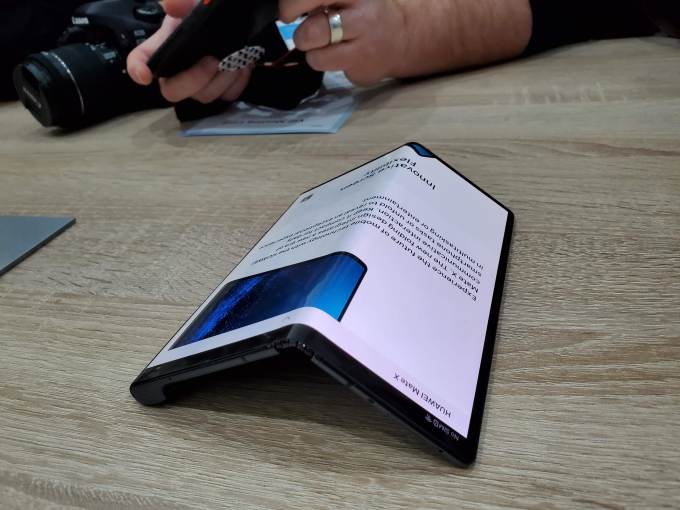
In this case, that mostly means knowing the limitations of what the near-final product can actually do. For now, that means web browsing, some photography and opening up Google Maps — which, to be fair, comprises a fairly large chunk of what people will actually be doing with the product.
That said, there’s a lot to account for with a new form factor. After all, phone makers have gotten really good at working with a defined two-dimensional plan a decade after the introduction of the first iPhone and Samsung Galaxy device. Folding, flipping and bouncing between screens presents all sorts of new challenges.
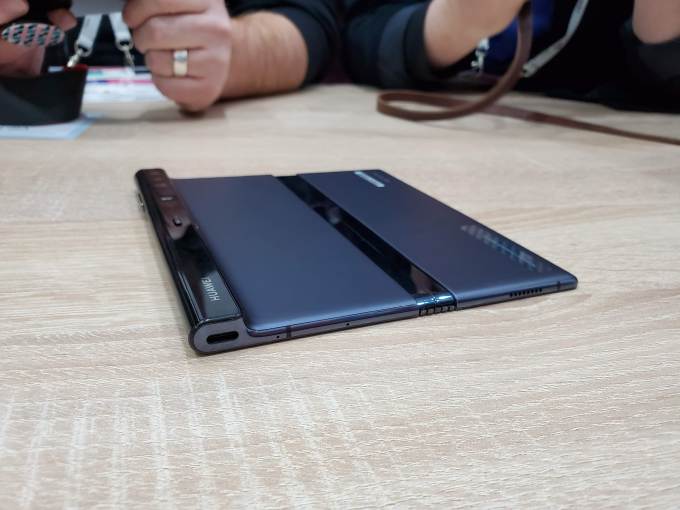
That said, in the demo at least, things seemed pretty smooth here. The device was pretty responsive in a less controlled environment than we’d previously seen it — or, for that matter, the Fold. There were a few moments and some blank screens for half a second or so, however, when the apps had to jump screens. All of which is to say the Mate X is real. I’ve seen it, and am so far pretty impressed with the execution.
The product design, too, is quite well thought-out. The product is surprisingly thin both folded and unfolded, and elements like the fold-over camera lip, which offers a place to grip (à la the lip on the rear of the Kindle Oasis) are nice touches.
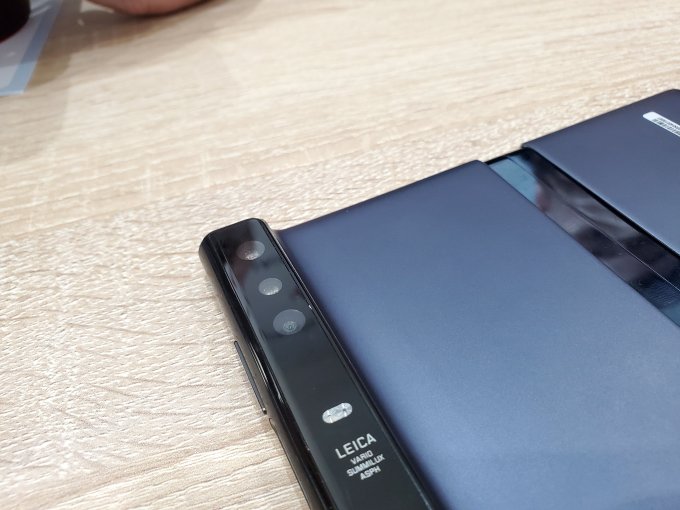
The screen, too, looks quite nice at first glance. That said, as with all of the foldables we’ve seen to date, capturing a glare from overhead light picks up crinkles on the display, along with a large seam in the middle, where the device folds over. You can’t feel them with your finger as you glide over to touch, but it’s easy to imagine how messy all of this could ultimately look after a few years of use.
The system also works when folded at a 90-degree angle, which could prove useful for future executions that Huawei is looking into. It’s clear that this is just the beginning of not only the form factor, but practical applications. It’s going to be fun watching developers figure out all of the stuff they can do with the product.
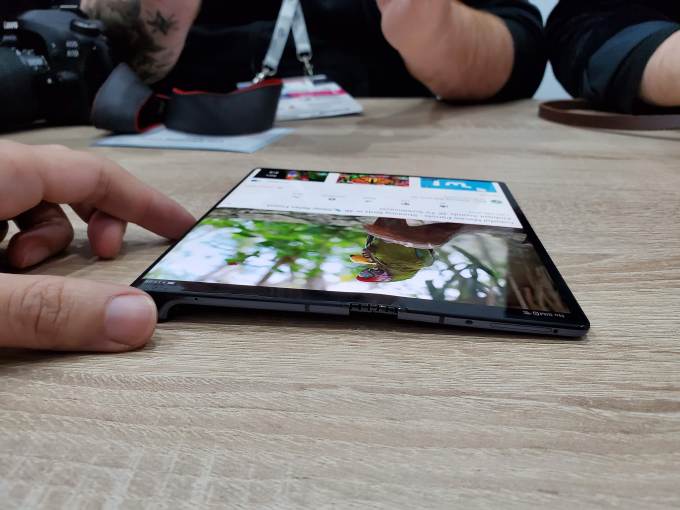
That “still early days” approach also applies to price point. Huawei acknowledges that the device is prohibitively expensive at ~ €2,200. That price includes the design to add 5G to the product — notably, there is no non-5G version planned, unlike the Galaxy Fold. That will no doubt make the Mate X even more of a niche product, until the next-gen cellular service rolls out for more users.
In a way, the Mate X is a proof of concept — albeit proof that the thing can be relatively mass-produced. At double the cost of a high-end flagship, I don’t expect the company plans to sell a lot of these, but the more it’s able to scale, the lower the price will ultimately be.
Powered by WPeMatico
Huawei: ‘The US security accusation of our 5G has no evidence. Nothing.’
Huawei’s rotating chairman Guo Ping kicked off a keynote speech this morning at the world’s biggest mobile industry tradeshow with a wry joke. “There has never been more interest in Huawei,” he told delegates at Mobile World Congress. “We must be doing something right!”
The Chinese company is seeking to dispel suspicion around the security of its 5G network equipment which has been accelerated by U.S. president Trump who has been urging U.S. allies not to buy kit or services from Huawei. (And some, including Australia, have banned carriers from using Huawei kit.)
Last week Trump also tweet-shamed U.S. companies — saying they needed to step up their efforts to rollout 5G networks or “get left behind”.
In an MWC keynote speech yesterday the European Commission’s digital commissioner Mariya Gabriel signalled the executive is prepared to step in and regulate to ensure a “common approach” on the issue of network security — to avoid the risk of EU member states taking individual actions that could delay 5G rollouts across Europe.
Huawei appeared to welcome the prospect today.
“Government and the mobile operators should work together to agree what this assurance testing and certification rating for Europe will be,” said Guo, suggesting that’s Huawei’s hope for any Commission action on 5G security.
“Let experts decide whether networks are safe or not,” he added, implying Trump is the opposite of an expert. “Huawei has a strong track record in security for three decades. Serving three billion people around the world. The U.S. security accusation of our 5G has no evidence. Nothing.”
Geopolitical tensions about network security have translated into the biggest headache for Huawei which has positioned itself as a key vendor for 5G kit right as carriers are preparing to upgrade their existing cellular networks to the next-gen flavor.
Guo claimed today that Huawei is “the first company who can deploy 5G networks at scale”, giving a pitch for what he described as “powerful, simple and intelligent” next-gen network kit, while clearly enjoying the opportunity of being able to agree with U.S. president Trump in public — that “the U.S. needs powerful, faster and smarter 5G”. 
But any competitive lead in next-gen network tech also puts the company in prime position for political blowback linked to espionage concerns related to the Chinese state’s access to data held or accessed by commercial companies.
Huawei’s strategy to counter this threat has been to come out fighting for its commercial business — and it had plenty more of that spirit on show this morning. As well as a bunch of in-jokes. Most notably a reference to NSA whistleblower Edward Snowden which drew a knowing ripple of laughter from the audience.
“We understand innovation is nothing without security,” said Guo, segwaying from making a sales pitch for Huawei’s 5G network solutions straight into the giant geopolitical security question looming over the conference.
“Prism, prism on the wall who is the most trustworthy of them all?” he said, throwing up a colorful slide to illustrate the joke. “It’s a very important question. And if you don’t ask them that you can go ask Edward Snowden.”
You can’t use “a crystal ball to manage cybersecurity”, Guo went on, dubbing it “a challenge we all share” and arguing that every player in the mobile industry has responsibility to defuse the network security issue — from kit vendors to carriers and standards bodies, as well as regulators.
“With 5G we have made a lot of progress over 4G and we can proudly say that 5G is safer than 4G. As a vendor we don’t operate carriers network, and we don’t all carry data. Our responsibility — what we promise — is that we don’t do anything bad,” he said. “We don’t do bad things.”
“Let me says this as clear as possible,” he went on, putting up another slide that literally underlined the point. “Huawei has not and will never plant backdoors. And we will never allow anyone to do so in our equipment.
“We take this responsibility very seriously.”

Guo’s pitch on network trust and security was to argue that where 5G networks are concerned security is a collective industry responsibility — which in turn means every player in the chain plays a monitoring role that allows for networks to be collectively trusted.
“Carriers are responsible for secure operations of their own networks. 5G networks are private networks. The boundary between different networks are clear. Carriers can prevent outside attacks with firewalls and security gateways. For internal threats carriers can manage, monitor and audit all vendors and partners to make sure their network elements are secure,” he said, going on to urge the industry to work together on standards which he described as “our shared responsibility”.
“To build safer networks we need to standardize cybersecurity requirements and these standards must be verifiable for all vendors and all carriers,” he said, adding that Huawei “fully supports” the work of industry standards and certification bodies the GSMA and 3GPP who he also claimed have “strong capabilities to verify 5G’s security”.
Huawei’s strategy to defuse geopolitical risk by appealing to the industry as a whole to get behind tackling the network trust issue is a smart one given the uncertainty generated by Trump’s attacks is hardly being welcomed by anyone in the mobile business.
Huawei’s headache might lead to the industry as a whole catching a cold — and no one at MWC wants that.
Later in the keynote Guo also pointed to the awkward “irony” of the U.S Cloud Act — given the legislation allows U.S. entities to “access data across borders”.
U.S. overreach on accessing the personal data of foreign citizens continues to cause major legal headaches in Europe as a result of the clash between its national security interest and EU citizens fundamental privacy rights. So Guo’s point there won’t have been lost on an MWC audience packed with European delegates attending the annual tradeshow.
“So for best technology and greater security choose Huawei. Please choose Huawei!” Guo finished, ending his keynote with a line that could very well make it as an upbeat marketing slogan writ large on one of the myriad tech-packed booths here at Fira Gran Via, Barcelona.
Powered by WPeMatico
HTC’s blockchain phone can now be purchased with fiat currency
Until now, the Exodus 1 has, fittingly, only been available for purchase with cryptocurrency. Starting today, however, interested parties will be able to pick HTC’s blockchain phone up through more traditional means, including USD, which prices the handset at a not unreasonable $699.
One assumes, of course, if you’ve got enough of an interested in purchasing a blockchain phone that they’ve already got a bit of Bitcoin, Ether or Litecoin lying about. This move, however, is very clearly about helping growing the product beyond its initial soft launch. When the device was released last year, HTC was pretty clearly expecting to sell it in limited quantities to users who could essentially help beta test the product in the wild.
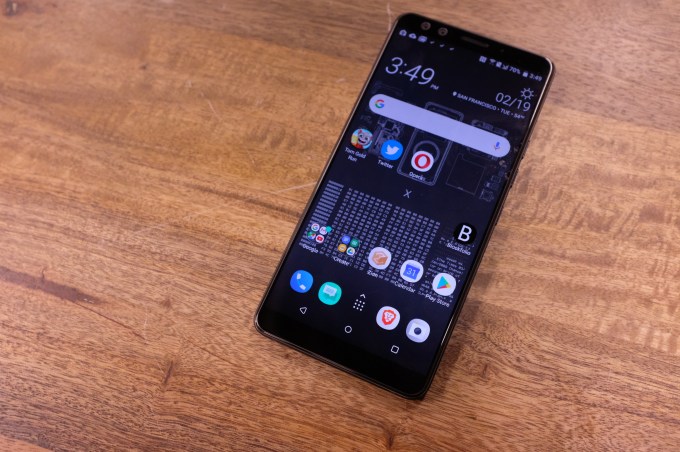
HTC Decentralized Chief Officer Phil Chen calls the product the company’s 1.0 solution. In fact, it’s planning to create a formal bounty program to discover and patch potential exploits.
But HTC has long held that a device like this will play an important role in the future of a company struggling to find its way as it feels the burn of a stagnating mobile industry. As project head and Chen told me on stage at a TechCrunch event in Shenzhen last year that HTC is “as committed as they are to the Vive. I don’t think it’s number one of the priority list, but I would say it’s number three or four.”
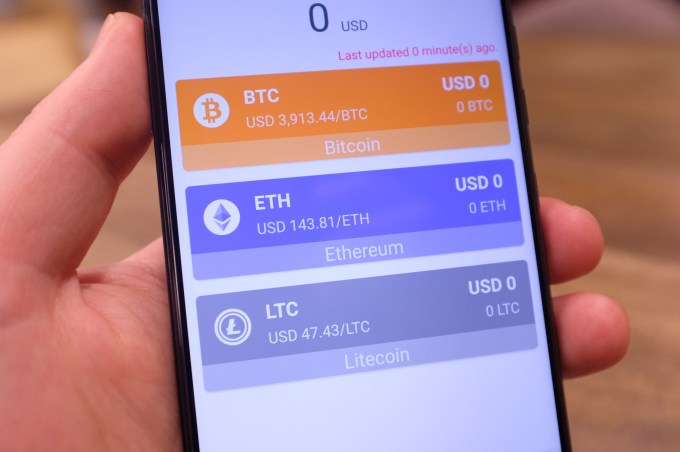
When I spoke to Chen again this month, just ahead of today’s Mobile World Congress announcement, he told me that HTC currently has 25 engineers committed to the project. It’s perhaps not a huge number in the grand scheme of a company the size of HTC, but it’s a sizable chunk of manpower, considering the fact that the product is mostly built using existing HTC hardware. The company has also brought in outside help like blockchain security expert Christopher Allen to make sure things are as secure as possible.
And indeed, I’ve been carrying an Exodus One around for about a week now, and it feels like a pretty standard HTC handset, both in terms of hardware and Android software, right down to the inclusion the size-squeezing Edge Sense.
Powered by WPeMatico
Climate change kills off clouds over the ocean in new simulation
We all know climate change is affecting weather systems and ecosystems around the world, but exactly how and in what way is still a topic of intense study. New simulations made possible by higher-powered computers suggest that cloud cover over oceans may die off altogether once a certain level of CO2 has been reached, accelerating warming and contributing to a vicious cycle.
A paper published in Nature details the new, far more detailed simulation of cloud formation and the effects of solar radiation thereupon. The researchers, from the California Institute of Technology, explain that previous simulation techniques were not nearly granular enough to resolve effects happening at the scale of meters rather than kilometers.
These global climate models seem particularly bad at predicting the stratocumulus clouds that hover over the ocean — and that’s a big problem, they noted:
As stratocumulus clouds cover 20% of the tropical oceans and critically affect the Earth’s energy balance (they reflect 30–60% of the shortwave radiation incident on them back to space1), problems simulating their climate change response percolate into the global climate response.
A more accurate and precise simulation of clouds was necessary to tell how increasing temperatures and greenhouse gas concentrations might affect them. That’s one thing technology can help with.
Thanks to “advances in high-performance computing and large-eddy simulation (LES) of clouds,” the researchers were able to “faithfully simulate statistically steady states of stratocumulus-topped boundary layers in restricted regions.” A “restricted region” in this case means the 5×5-km area simulated in detail.
The improved simulations showed something nasty: when CO2 concentrations reached about 1,200 parts per million, this caused a sudden collapse of cloud formation as cooling at the tops of the clouds is disrupted by excessive incoming radiation. Result (as you see at top): clouds don’t form as easily, letting more sun in, making the heating problem even worse. The process could contribute as much as 8 or 10 degrees to warming in the subtropics.
Naturally there are caveats: simulations are only simulations, though this one predicted today’s conditions well and seems to accurately reflect the many processes going on inside these cloud systems (and remember — inherent error could be against us rather than for us). And we’re still a ways off from 1,200 PPM; current NOAA measurements put it at 411 — but steadily increasing.
 So it would be decades before this took place, though once it did it would be catastrophic and probably irreversible.
So it would be decades before this took place, though once it did it would be catastrophic and probably irreversible.
On the other hand, major climatic events like volcanoes can temporarily but violently change these measures, as has happened before; the Earth has seen such sudden jumps in temperature and CO2 levels before, and the feedback loop of cloud loss and resulting warming could help explain that. (Quanta has a great write-up with more context and background if you’re interested.)
The researchers call for more investigation into the possibility of stratocumulus instability, filling in the gaps they had to estimate in their model. The more brains (and GPU clusters) on the case, the better idea we’ll have of how climate change will play out in specific weather systems like this one.
Powered by WPeMatico
Fortnite’s revenue dropped 48% in January but the lull likely won’t last long
If you thought Fortnite was looking mortal, you might want to reconsider.
New numbers from SuperData show that the Fortnite juggernaut lagged by one meaningful measure at the start of this year. Revenue from the game across platforms dropped by a hard-to-ignore 48 percent between December 2018 and January 2019. As the report notes, December was a peak month for the multiplayer third-person shooter, with Fortnite fever in full swing and holiday purchases driving revenue to record levels.
While a 48 percent revenue drop might sound like a mortal wound, the game’s unique sales model and seasonal trends mean that we shouldn’t start prepping any Fortnite obituaries any time soon. With a free-to-play model, Fortnite relies on in-game purchases of digital goods like dance animations and elaborate character skins to drive revenue. With no recurring subscription fees apart from quarterly season passes, Fortnite’s revenues were never going to track a more traditional game’s numbers.
Case in point: Fortnite maker Epic looks to have socked away $3 billion in profit over the course of last year. By November, data from Sensor Tower estimated that Fortnite players were spending $1.23 million a day just on iOS. Given Fortnite’s platform agnosticism, that’s just one stream of many, from mobile to console to PC.
For Fortnite, a dip in revenue also doesn’t necessarily indicate declining user numbers or less play overall — it just means people were less likely to spend money on virtual goods. Those purchases are purely cosmetic and don’t confer a meaningful competitive advantage, so it’s kind of a strange metric to judge the game’s overall current health, though obviously an important one for the business of the game.
A game like Fortnite is designed to be cyclical, with players rotating in as fresh content debuts. In December, Fortnite’s new Season 7 release converged with the holidays, making for a potent revenue-driving combination as players bought up new virtual goods, explored a reimagined map, had more time to play and had new devices to try out. By January, players were itching for the next major update.
“This is no doubt due to the fact that Season 7 began in December. We historically see a significant increase in Fortnite mobile revenue during the months when a new season debuts, as the player base purchases Battle Passes en masse,” Sensor Tower’s head of mobile insights Randy Nelson told TechCrunch.
“Substantial decreases in the subsequent month after a new season are not new; Fortnite revenue on iOS declined 33 percent between October and November 2018 based on our estimates, from $56 million to $36.6 million… In short, these peaks and valleys are common when looking at games based around season pass monetization on a schedule such as Fortnite’s.”
Overall, the January SuperData numbers show a 6 percent year-over-year decline in digital gaming across the board. If Epic was poised to see Fortnite hit stratospheric user and revenue growth last holiday season, the real test will be seeing if the game can keep its momentum all the way through 2019 as emerging competitors vie for a piece of the pie. With Season 8 due to infuse the game with a wave of fresh digital goods later this week, we should have a pretty good idea of Fortnite’s staying power by the time the new spring content is starting to go stale.
Powered by WPeMatico
Ubiquitilink advance means every phone is now a satellite phone
Last month I wrote about Ubiquitilink, which promised, through undisclosed means, it was on the verge of providing a sort of global satellite-based roaming service. But how, I asked? (Wait, they told me.) Turns out our phones are capable of a lot more than we think: they can reach satellites acting as cell towers in orbit just fine, and the company just proved it.
Utilizing a constellation of satellites in low Earth orbit, Ubiquitilink claimed during a briefing at Mobile World Congress in Barcelona that pretty much any phone from the last decade should be able to text and do other low-bandwidth tasks from anywhere, even in the middle of the ocean or deep in the Himalayas. Literally (though eventually) anywhere and any time.
Surely not, I hear you saying. My phone, that can barely get a signal on some blocks of my neighborhood, or in that one corner of the living room, can’t possibly send and receive data from space… can it?
“That’s the great thing — everybody’s instinct indicates that’s the case,” said Ubiquitilink founder Charles Miller. “But if you look at the fundamentals of the RF [radio frequency] link, it’s easier than you think.”
The issue, he explained, isn’t really that the phone lacks power. The limits of reception and wireless networks are defined much more by architecture and geology than plain physics. When an RF transmitter, even a small one, has a clear shot straight up, it can travel very far indeed.
Space towers
It’s not quite as easy as that, however; there are changes that need to be made, just not anything complex or expensive like special satellite antennas or base stations. If you know that modifying the phone is a non-starter, you have to work with the hardware you’ve got. But everything else can be shaped accordingly, Miller said — three things in particular.
- Lower the orbit. There are limits to what’s practical as far as the distance involved and the complications it brings. The orbit needs to be under 500 kilometers, or about 310 miles. That’s definitely low — geosynchronous is 10 times higher — but it’s not crazy either. Some of SpaceX’s Starlink communications satellites are aiming for a similar orbit.
- Narrow the beam. The low orbit and other limitations mean that a given satellite can only cover a small area at a time. This isn’t just blasting out data like a GPS satellite, or communicating with a specialized ground system like a dish that can reorient itself. So on the ground you’ll be looking at a 45 degree arc, meaning you can use a satellite that’s within a 45-degree-wide cone above you.
- Lengthen the wavelength. Here simple physics come into play: generally, the shorter the wavelength, the less transparent the atmosphere is to it. So you want to use bands on the long (lower Hz) side of the radio spectrum to make sure you maximize propagation.
Having adjusted for these things, an ordinary phone can contact and trade information with a satellite with its standard wireless chip and power budget. But there’s one more obstacle, one Ubiquitilink spent a great deal of time figuring out.
Although a phone and satellite can reach one another reliably, a delay and Doppler shift in the signal due to the speeds and distances involved are inescapable. Turns out the software that runs towers and wireless chips isn’t suited for this; the timings built into the code assume the distance will be less than 30 km, since the curvature of the Earth generally prevents transmitting farther than that.
So Ubiquitilink modified the standard wireless stacks to account for this, something Miller said no one else had done.
“After my guys came back and told me they’d done this, I said, ‘well let’s go validate it,’ ” he told me. “We went to NASA and JPL and asked what they thought. Everybody’s gut reaction was ‘well, this won’t work,’ but then afterwards they just said ‘well, it works.’ ”
 The theory became a reality earlier this year after Ubiquitilink launched their prototype satellites. They successfully made a two-way 2G connection between an ordinary ground device and the satellite, proving that the signal not only gets there and back, but that its Doppler and delay distortions can be rectified on the fly.
The theory became a reality earlier this year after Ubiquitilink launched their prototype satellites. They successfully made a two-way 2G connection between an ordinary ground device and the satellite, proving that the signal not only gets there and back, but that its Doppler and delay distortions can be rectified on the fly.
“Our first tests demonstrated that we offset the Doppler shift and time delay. Everything else is leveraging commercial software,” Miller said, though he quickly added: “To be clear, there’s plenty more work to be done, but it isn’t anything that’s new technology. It’s good solid hardcore engineering, building nanosats and that sort of thing.”
Since his previous company was Nanoracks and he’s been in the business for decades, he’s qualified to be confident on this part. It’ll be a lot of work and a lot of money, but they should be launching their first real satellites this summer. (And it’s all patented, he noted.)
Global roaming
The way the business will work is remarkably simple given the complexity of the product. Because the satellites operate on modified but mostly ordinary off-the-shelf software and connect to phones with no modifications necessary, Ubiquitilink will essentially work as a worldwide roaming operator that mobile networks will pay to access. (Disclosure: Verizon, obviously a mobile network, owns TechCrunch, and for all I know will use this tech eventually. It’s not involved with any editorial decisions.)
Normally, if you’re a subscriber of network X, and you’re visiting a country where X has no coverage, X will have an agreement with network Y, which connects you for a fee. There are hundreds of these deals in play at any given time, and Ubiquitilink would just be one more — except its coverage will eventually be global. Maybe you can’t reach X or Y; you’ll always be able to reach U.
The speeds and services available will depend on what mobile networks want. Not everyone wants or needs the same thing, of course, and a 3G fallback might be practical where an LTE connection is less so. But the common denominator will be data enough to send and receive text at the least.
It’s worth noting also that this connection will be in some crucial ways indistinguishable from other connections: it won’t affect encryption, for instance.
This will of course necessitate at least a thousand satellites, by Miller’s count. But in the meantime, limited service will also be available in the form of timed passes — you’ll have no signal for 55 minutes, then signal for five, during which you can send and receive what may be a critical text or location. This is envisioned as a specialty service at first, then as more satellites join the constellation, that window expands until it’s 24/7 and across the whole face of the planet, and it becomes a normal consumer good.
Emergency fallback
While your network provider will probably charge you the usual arm and leg for global roaming on demand (it’s their prerogative), there are some services Ubiquitilink will provide for free; the value of a global communication system is not lost on Miller.
“Nobody should ever die because the phone in their pocket doesn’t have signal,” he said. “If you break down in the middle of Death Valley you should be able to text 911. Our vision is this is a universal service for emergency responders and global E-911 texting. We’re not going to charge for that.”
An emergency broadcast system when networks are down is also being planned — power outages following disasters are times when people are likely to panic or be struck by a follow-up disaster like a tsunami or flooding, and reliable communications at those times could save thousands and vastly improve recovery efforts.
“We don’t want to make money off saving people’s lives, that’s just a benefit of implementing this system, and the way it should be,” Miller said.
It’s a whole lot of promises, but the team and the tech seem capable of backing them up. Initial testing is complete and birds are in the air — now it’s a matter of launching the next thousand or so.
Powered by WPeMatico





